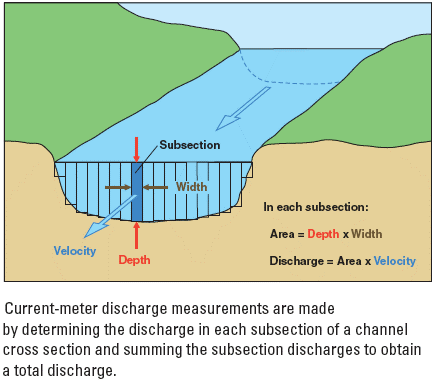Discharge
The volume of water flowing through a given cross-section of a river in a unit of time (usually per second). This is one of the main characteristics of a river, which informs us how much water flows in the riverbed. The most common unit used to measure the discharge is cubic meter per second.
Generally, it can be described using the following formula:
Q (m3/s) = A (m2) x V (m/s) where discharge = area x velocity
In hydrometry there are many methods of measuring the discharge of a river. The most appropriate method is chosen, depending on the size of a river and its characteristics.. Nowadays, hydrological services responsible for hydrological measurements, mainly use methods based on the measurement of a river velocity and its cross-sectional area (eg current-meter method, ADCP method).
River discharge is an important parameter in many hydrological, environmental and engineering calculations, including in estimating water resources, calculating the water balance or designing various types of hydro technical constructions.



 This project (EDU-ARCTIC) has received funding from the European Union’s Horizon 2020 research and innovation programme under grant agreement No 710240. The content of the website is the sole responsibility of the Consortium and it does not represent the opinion of the European Commission, and the Commission is not responsible for any use that might be made of information contained.
This project (EDU-ARCTIC) has received funding from the European Union’s Horizon 2020 research and innovation programme under grant agreement No 710240. The content of the website is the sole responsibility of the Consortium and it does not represent the opinion of the European Commission, and the Commission is not responsible for any use that might be made of information contained.